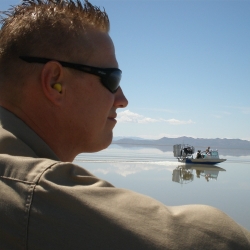Wildlife Biologist
Great Salt Lake Ecosystem Program
Utah Division of Wildlife Resources
Bio:
John Luft received his degree from Kansas State University studying Fisheries and Wildlife Biology in 1991. He subsequently moved to Utah in 1994, where he began working for the Utah Division of Wildlife Resources. He has spent most of his career focused on the avian community in one capacity or another. First spending 6 years working at Ogden Bay and Farmington Bay Waterfowl Management Areas (WMA’s) where he focused primarily on waterfowl and wetland habitat management. In 2003, he accepted the position of Avian Biologist for the Great Salt Lake Ecosystem Program (GSLEP). The Great Salt Lake Ecosystem Program monitors, manages and performs research on or around the lake in order to preserve the lakes resources. The project focuses primarily on the brine shrimp industry and coordinated avian monitoring around the Great Salt Lake. In November 2006, he accepted the Program Manager position for the Great Salt Lake Ecosystem Program and has served in that capacity over the last decade.
Title: The Importance of Salinity to the Great Salt Lake Ecosystem
Wednesday, May 8th, 10:20 AM
Abstract: Great Salt Lake is separated into four distinct bays with unique ecologies. At the forefront of these distinctions is salinity, essentially determining the ecology of each bay. The Great Salt Lake Ecosystem Program (GSLEP) has been monitoring salinity, as well as other limnological parameters, for over 20 years. This research studies the impact of salinity to determine how it affects brine shrimp and brine flies in the lake. Long-term monitoring of the lake and its biota provides a basis for GSLEP to manage the brine shrimp fishery on Great Salt Lake in order to maintain a productive fishery and ensure the forage base for many avian species. This approach has succeeded in developing a cooperative relationship with the brine shrimp harvest industry and conservation efforts in order to preserve this unique ecosystem.

